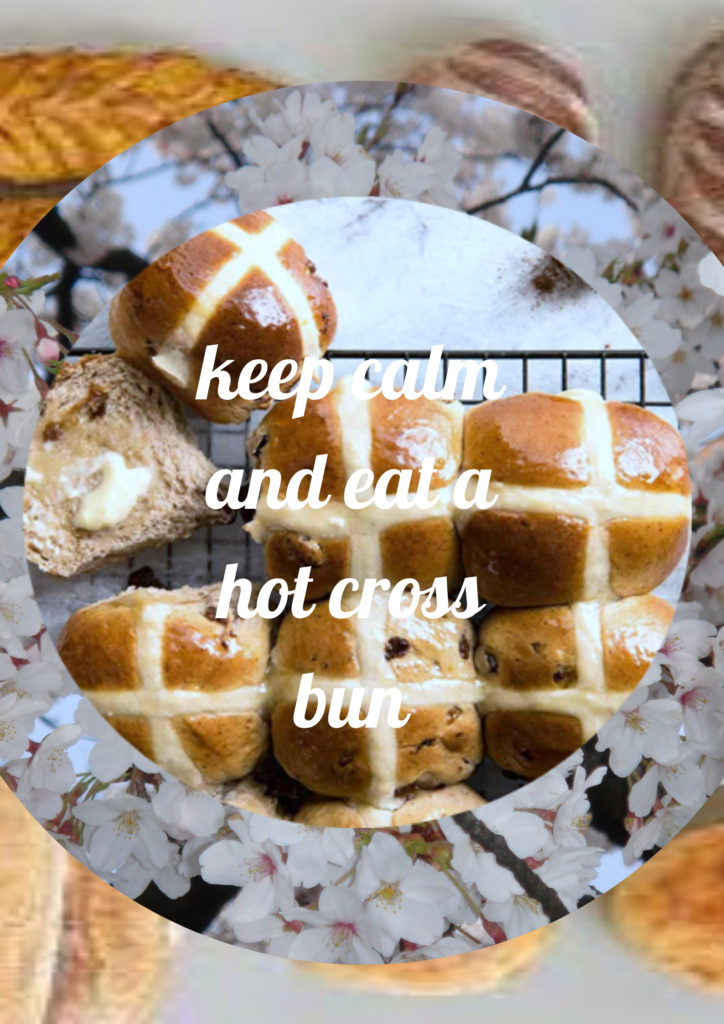It’s spring, Easter is coming, and we here at Madeleine’s have a feeling for buns …
What exactly do we mean?
Well, it might be fun to spend the spring season eating our way through the a number of cakes or buns with meaning!
As we are about to set off to spend an April week in London, just 2 weeks before Easter, we are eyeing the hot cross bun which, we hasten to add, is Brexit-proof and will survive the do-we-or-do-we-not as Britain sooner or not so sooner consider again whether it will be part of European Union or not. Seeing and smelling hot cross buns in bakeries and cafes around town always reminds us that Easter and therefore spring is coming. While some experts have told us that there is a global shortage of raisins, sultanas and currants caused by recent wildfires in California, the hot cross bun makers have either not heard about that or beaten it, thankfully, and if you like us are in London just before Easter, you will be able to get your hands on a few of these great-smelling and heart-warming buns. It has even been reported that hot cross buns are hot these days, though there are cold ones too, as hot cross bun ice cream is reportedly and absolutely a thing that exists, to be found in some of London’s most illustrious super-markets (oh, the [culinary] irony of it, the cold and hot [cross] bun!).
If you marvel at the English celebrating a Christian event so seriously with a “cross” in their buns, then spare a (delicious) thought for the Italians who do not just put a cross on their bun, they bake a large cake that is cross-shaped, even if its name colomba (or its full name, the colomba di pasqua) says it is the Easter dove! There are indeed many legends and stories around the origin of the Colomba including that of two doves representing the Holy Ghost. Symbolism aside, these are as delicious as the Panettone that has become top-of-the-list for many people in different places celebrating Christmas these days, and very much like Panettone, it is a rich and flurry cake and traditionally made with high-quality flour, farm-fresh eggs, sugar, butter, and natural yeast that takes at least 30 hours to rise.
However, if you are talking about buns with meaning, nothing beats the mooncake which was concocted up by revolutionaries almost 800 years ago in China to hide some message for a rebellion, even if mooncakes are not about spring but autumn!
And, yes, these cakes not only had meanings but were literally used to pass messages. Would you like to go in search of the lady who had some special cake to pass on (and then go look for the message inside the cake), instead of going on Facebook to see what the message was? Or, imagine the protesters in Paris creating a special gilets jaunes (or “yellow vests”) gâteau or the “liberty croissant” and embedding messages inside them and passing to each other as a means to communicate some secret message? (This croissant liberté is not to be confused with the Pâtisserie Boulangerie Liberté* in the trendy Canal St Martin area in the 10th arrondissement which bakes top-notch breads and cakes including a delectable croissant, with its pastry chef Benoît Castel having formerly created delights for luxury Parisian food hall La Grande Epicerie and this being his second address in the capital). Certainly, the bun will have to be yellow in colour, with some saffron perhaps? Special note to the creative Parisian baker! .
Well, we all have to wait for the best part of the year before the mooncakes “come into season”, and, come September, it is easy enough to find mooncakes these days even if you’ll generally have to be in a Chinese city such as Hong Kong and find yourself there in mid-autumn (visit Hong Kong anyway if you are into food!). Even better, you can go visit your friends while there; the custom is also to bring one’s lanterns to the park to watch the moon.
And so, we have cakes with meaning in spring and autumn, whether the meanings are to do with peace and faith or for a more inclusive community; we only need a certain kind of political leadership that can tap into this desire for shared meanings and bring different communities together!
* 39 rue des Vinaigriers (Rue Lucien Sampaix)
75010 Paris





